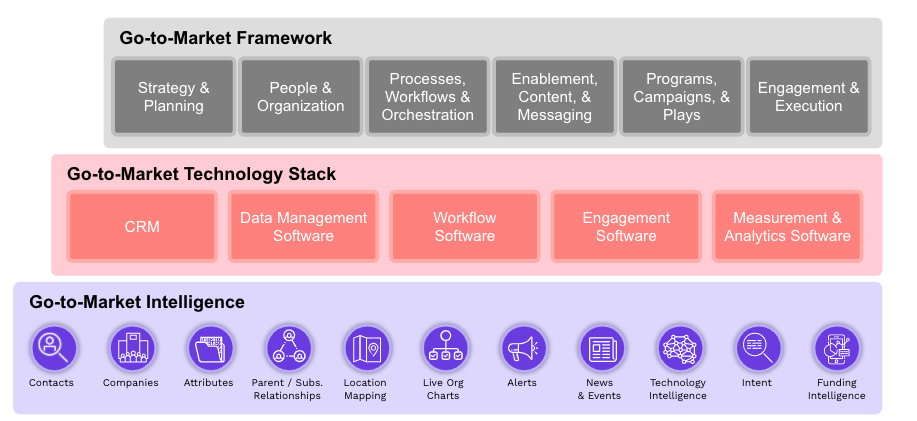Realizing that there is such a small gap between good and great can either be terrifying or empowering.
It’s not uncommon to hear about horse races where the second place jockey is behind by two-and-a-half lengths.
Take the 2018 Kentucky Derby as an example: Good Magic lost to Justify by that exact amount.
That’s a half-second difference between a winner and a second place ribbon.
At ZoomInfo, that gap is what drives us.
Setting The Scene
I hear it all the time – especially when I’m talking to VCs and Private Equity firms – Company X has an INCREDIBLE product, but they just haven’t built a go-to-market motion around it.
Most companies don’t die because of lack of ideas, or innovation, or size of market – they die because they just didn’t build a predictable, repeatable, and efficient motion around finding and keeping their next customer.
It’s no secret we’ve been especially busy in 2020. And because of what’s happening within ZoomInfo in the context of the current economic conditions, I’ve found myself discussing our growth trajectory, time and again, at virtual conferences, investor meetings, and with mainstream media outlets.
It’s involved training, dedication, and innovation. And now we have an incredible go-to-market engine. Details? We got them! Our go-to-market engine:
In part one of our inside look series, we’re going to show you how we’re using data and CRM systems to drive genuine effectiveness.
Why You Need a Go-to-Market Motion
The business world is constantly changing. No company looks the same on December 31st as they looked on January 1st.
Businesses grow, shrink, get funding, invest in tech, ditch tech, hire new talent, loose old talent – the list goes on. The information that you have in your CRM could be good today but there’s also a decent chance it’s going to be bad tomorrow.
The foundational layer of how we go-to-market is built on using insights that drive who you should be marketing and selling to, when you should be marketing and selling to them, and what you should say.
Simply put: the right message, to the right company, to the right person, at the right time.
That’s what ZoomInfo provides.
What ZoomInfo enables is far more far more impactful. We breathe life into a sales floor, we boost morale, we reduce turnover, we drive the sales and marketing pipeline, and we help companies grow.
Hypergrowth B2B companies need to embrace the Go-to-Market Motion. Or they risk losing the race.
ZoomInfo’s Go-to-Market Framework
GTM motions create momentum, not disruption, through data. It creates truth and accountability, no matter if you’re chasing (demand gen) waterfalls or filling (sales) funnels. Data is the end-all-be-all maestro behind the people, processes, and technologies that are part of your GTM success.
I’m going to walk you through our go-to-market motion. I want to start by asking you to consider how your go-to-market motion is organized.

But the foundational layer is all about data. We’re talking about the information on your target market, the companies, the people, the attributes that make up those companies, where they’re located, the organizational charts, what’s going on in those businesses, that’s the foundation of your go-to-market motion.
But the real secret sauce through all of this is how we optimize against each and every one of these areas. We track how many:
Leads are converting on any page of our website
Fields we use in specific web forms
Sales activity metrics
Trends in product usage that signal potential up-sell opportunities
We are tracking, measuring and optimizing literally everything we do. It’s a part of our culture. Why? Because that is the 2-second difference we were talking about.
It makes all the difference in the world. Let’s review.
Go-to-Market Motion #1: Speed to Lead
Our marketing team generates over 10,000 hot inbound leads every month. And we have a dedicated group of 70 inbound SDRs that we feed those leads to, that’s their specialized function.
The infrastructure we put in place requires —and enables — our sales team to respond to each of those 10,000 leads in under 90 seconds.
Read that again.
Go to our website right now, fill out a form, and we guarantee someone will be on the phone with you in 90 seconds.
We’re serious.
As a result, of those 10,000 leads, we are booking 6,500 demos, on average, every single month.
It’s not easy to get to that point, though. You just can’t buy technology and say, “Okay, I’m going to respond to a lead in 90 seconds.”
And here’s the thing: even with the best intentions, there are 100 places where speed to lead can blow up culturally. When we initially created the expectation the reaction was what you would expect.
“Well, what if I’m stuck in a meeting or on another call?”
“I just emailed some leads because they don’t always include a phone number.”
The response was simple: Trust the process. We explained to our reps why it was important and then we built systems that accounted for all of the issues our reps mentioned. For example: Busy with something more urgent? No problem, flag a break in our system and we’ll route it around you.
And make no mistake, lead response time is critical. There is a 10X decrease in your chances to connect with a lead if you don’t call them in the first few minutes. When we get back to a lead in under 90 seconds, it exponentially increases the likelihood of us converting that lead and so we operationalize it, we optimize it.
So, we made a cultural commitment. I even personally test our sales team every month. I go on the website, make up a fake person and then I wait for the callback.
What Else Are We Doing to Drive Results from Marketing Channels?
We can only hold our sales team accountable if they have both the lead volume and understanding of how to follow up.
The first requirement can be tackled from a number of different ways, but web form management is a key inflection point our leadership focuses on.
Case in point: there’s an ongoing debate, especially in B2B, about how to minimize the number of fields required for someone to fill out a form on a company website.
Most of the conversations will weigh pros against the cons around web form management: less fields may mean more conversions, but it also means less information to score off of and puts sales reps at a disadvantage about who the lead is and what they care about.
Fortunately, at ZoomInfo, we don’t compromise quality at the expense of volume. We’re using our FormComplete application to handle inbound leads. As leads convert, we’re appending key information we wouldn’t otherwise ask for on a form, but nonetheless, is essential to boost the sales team’s ability to book demos from marketing qualified leads.
Of course, we’re verifying contact information and basic data points, but we’re also able to append tailored data points, like industry, size, growth rate and where they’re located. how many sales employees the lead has on staff, which is important for our business.
By understanding how a business operates we’re able to lead score in a way that actually matches our ability to provide value and close business.
Go-to-Market Motion #2: Solving for the Sale
When you ask sales leaders about their best sales rep, the answer is usually the person with the most closed deals. And while that might be true, when you’re in the environment that we’re in, Annual Contract Value (ACV) may not represent the best-of-the-best within a sales organization.
Again, we use data here and mirror the model on the lead distribution side of our process. How? Our account executives are ranked in order of who is most likely to turn particular leads into a closed-won opportunity.
The performance-based system looks at five key metrics:
Trailing three-month ACV won
Trailing three-month win rate
Trailing three-month Average Sales Price (ASP)
Trailing three-month opportunity creation
Trailing three-month ACV per opportunity
Just like the inbound SDRs, who are held accountable for the 90 second response time, attendance rate, and qualification rate, we have a transparent structure that provides every account executive visibility into how they’re ranked, how they’re rated, in a way that they believe to be fair.
They know where they stand every month, and they know these metrics will directly affect their wallet, because their ranking directly affects the quality of leads that they get.
With this system in place, we can go a level deeper to make sure we’re capturing context. For instance, as a sales organization, we know how the account executives stack-rank against different groups; ramping vs. non-ramping, corporate vs. strategic.
This normalizes high transparency so everybody knows where they stand. The impact of this culturally has been phenomenal for us.
Go-to-Market Motion #3: Automate & Create
Let me touch on a couple of the different ways that we automate different processes.
As we’re setting those 6,500 demos a month, inevitably, some people don’t show up.
Like everything, we’re always trying to optimize our show rate – the people who show up vs. the people who don’t. To the surprise of no one, the longer we wait to book demos, the less likely we are to get a show.
The closer to the day that I set the demo, the higher likelihood that it’s going to go off. Using this logic, we’ve managed to achieve a 75% completion rate on demos booked.
The next step is to consider what to do with the people who don’t show up. We built checks and balances that automatically places no-shows into a “win-back” campaign. Again, using a systematic process, we actually generate over a million dollars of ACV every month against the people who didn’t originally show up to the meeting we scheduled them for.
It’s not special, it’s not novel, but it’s a process that runs effectively, we’re constantly optimizing it and it generates real ACV for us that we wouldn’t otherwise see.
And this is just an example of us picking stuff up that other people let hit the floor.
Win, Fail, Adapt, Repeat
Here’s the thing: The race doesn’t really stop. There’s no clear finish line in our story. As we continue to succeed, we’ll find new roadblocks, new improvements and new ways to adapt. Our technology, our data, our people and our processes enable us to continuously evolve.
Want to learn more about how we built our GTM strategy? In Part 2, we’ll explore how we’ve built our sales team to target the full spectrum of accounts – from recruitment to automated workflows.
Stay tuned!
This blog was originally published on the OpenView blog.


